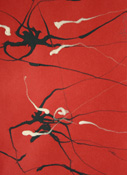
From the NY Times, the saga continues.
They've made the entire 16-page manifesto available on the web, well worth checking out.
From what I've read so far, the splashers are no dummies when it comes to art and culture, but seem gravely misguided in how they are directing their well-developed creative sensibilities, in my humble opinion.
I'm all for interventional acts of resistance, but in this case, it's all mired in reactionary hatred and cynicism, which the world already has too much of, and is too easy a trap to fall into, instead of acknowledging the formidable challenges of actually showing up and making your own art, and finding a way to survive and still maintain a productive creative practice.
In that sense, the splashers' destructive, violent acts strike me as mere self-absorbed, misplaced anger and frustration. Instead of doing the internal work on themselves that would enable them to rise above their own envy and resentment to create honest work with the potential to transform individuals and civil society, through an engaging aesthetics of both ideas and form, they lash out at the world and the art around them.
Where's the value in that? Where's the honesty and vulnerability? Where is the art in their intervention? And where is the accountability for their actions?
This critic offers another take: proof that art still matters.






